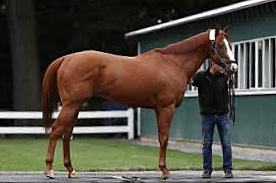By Barbara Newtown.
Justify, the 2018 Triple Crown champion, has shattered a 136-year-old curse: In 1882, Apollo, unraced as a two-year-old, won the Kentucky Derby. Until Justify came along, 61 other Thoroughbreds had tried to ace the Derby without competing during their two-year-old year. Add to Justify’s Derby accomplishment the horse’s capture of the Triple Crown, and you have the ultimate icing on a pretty tasty cake.
I asked Glenn Delahoussaye, renowned Louisiana Thoroughbred trainer, for his take on Justify’s blazing-fast rise to stardom.
How did Justify pull it off? The first place to search is his pedigree. Glenn doesn’t look for esoteric “nicks” as much as he looks for general quality. The bottom half of Justify’s pedigree boasts not only big earners like his damsire Ghostzapper ($3,446,120 in 11 starts), but also spectacular breeding-shed stars like Pulpit. On the top half, Justify’s sire Scat Daddy shows strong influence from Mr. Prospector and the Storm Cat line. Scat Daddy was the top freshman sire in both North America and Chile, and in 2015 the horse set the North American record for siring juvenile stakes winners. Two-year-old winners and late maturing winners are all represented in Justify’s lineage. The quality throughout the pedigree, top and bottom, is undeniable.
In 2016 Justify sold at the Keeneland auction for $500,000. Those who bid on the colt saw what Glenn calls the “it” factor: presence. Glenn says, “Justify, as a yearling, was a magnificent physical specimen. He’s eye candy! We look too much at what we read—the pedigree—and we forget what we’re looking at, actual flesh and blood. That’s what does the running. You could say that Justify outran his pedigree.” Glenn compares racehorses to human children: the most athletic parents can produce a kid who prefers to lie on the couch and read… and the laziest parents can produce an All-American athlete. Always consider the individual. Pictures of Justify as a youngster show a handsome horse with strong, well-muscled hindquarters and solid bone structure with excellent angles. By the time of his Triple Crown win, his shoulder and withers had matured, and he stood at 16.3 hands – an inch taller than “Big Red,” Secretariat. Observers have remarked on Justify’s long, efficient stride: his muscles and tendons are flexible enough to reach farther with each step than his competitors can reach.
Does the training make that much of a difference? Glenn offers a guarded yes. Bob Baffert is the best of the best. Justify had some minor foot problems during his two-year-old year and Baffert resisted the temptation to put the very expensive horse into a race. Training continued, though: gate work, responsiveness to the rider, general fitness. Since Justify didn’t have to recover from races during that year, his training could proceed without interruption. However, Glenn points out that Baffert did nothing different than what he would do with any of his horses. “There’s an old saying: a loaded gun is dangerous in anybody’s hand. Trust me, Justify was a loaded gun! Baffert’s a great trainer, but Justify is an exceptional horse.”
How about the talents of the jockey? Mike Smith is a veteran rider. He’s at the stage of his career where he can pick and choose. “His nickname is Big Money Mike,” says Glenn. “He’s a good Christian man, he has no flaws. He gets along with horses, he’s got beautiful hands and balance, and he’s a tactician on the track. He can figure a race out: he can watch the competition and decide where he needs to be.” Glenn points out that Mike got his start in New Mexico racing Quarter Horses, “which makes him a very good gate rider today. People with Quarter Horses in their roots understand you’ve got to get away from the starting gate!” Trainer Bob Baffert also got his start in Quarter Horse racing.
How stiff was the competition? Justify’s Triple Crown victory was well earned. The horses which challenged him in the Derby, Preakness, and Belmont went on to win big races after Justify retired. There’s another form of competition: the horse versus the track. Justify was tested by extremes: the Derby and the Preakness were run on sloppy, wet tracks; the Belmont’s track was fast, sandy, and dry. The consensus is that Justify is not inherently a “mudder” – a horse who likes to run through slop. His natural speed and his natural competitive streak put him ahead of his challengers, even when the surface was something he may have disliked.
The most astonishing fact about Justify’s accomplishment is that ALL his racing took place in 2018. His raced/won ratio is 6/6:
- 7 furlong maiden special weight race (February 18, 2018)
- 1 mile allowance race (March 11, 2018)
- 1 1/8 mile Santa Anita Derby (April 7, 2018)
- 1 ¼ mile Kentucky Derby (May 5, 2018)
- 1 1/8 mile Preakness (May 19, 2018)
- 1 ½ mile Belmont (June 9, 2018)
It took less than four months for Justify to reach the pinnacle of Thoroughbred racing.
Justify retired to the breeding shed after Baffert noticed some swelling in his left ankle. Fans of Thoroughbred racing will always wonder: which horse is better, Justify or American Pharoah, the 2015 Triple Crown winner? American Pharoah went on to run three more races after the Triple Crown: the Haskell, which he won; the Travers, which he lost by ¾ of a length; and the 2015 Breeders’ Cup Classic, in which he competed against a field that included older, more experienced horses. He retired sound.
It’s possible that excellent veterinary care would have made it possible for Justify to race more… particularly as an entry in the Breeders’ Cup, thereby producing more data for the armchair arguments. But a comparison between the two horses is skewed by economics. The owner of American Pharoah had sold the breeding rights; the only way he could keep making money from his horse was to continue racing him. Justify, on the other hand, at the time of the Belmont was owned by a group populated by WinStar Farm, China Horse Club, Head of Plains Partners LLC, Starlight Racing, and, according to The New York Times, George Soros. They will earn far more from Justify the stud than from Justify the fan-pleasing racing hero. As Glenn says, “It’s all about the return on investment—the ROI.”
At this point, the ROI shifts to the babies. American Pharoah’s first crop of weanlings hit the sales last fall. Bloodhorse magazine reported that the youngsters have athletic physiques and good minds. The horse world awaits the offspring of Justify.






